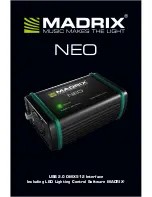
3.0
GENERAL THEORY OF OPERATION
3.1
REVERSE OSMOSIS THEORY
Reverse osmosis, like many other practical scientific methods, has been developed from
processes first observed in nature. Osmosis is a naturally occurring phenomenon in which a
semi-permeable membrane separates a pure and a concentrated solution (a semi-permeable
membrane is defined as one that preferentially passes a substance). Every fluid has an
inherent potential that is directly related to the type and number of solids in solution. This
potential, referred to as osmotic pressure, increases in proportion to relative concentration
of a solution. A concentrated solution, therefore, has an osmotic pressure that is higher than
that of a pure solution.
In a desalination system, the less concentrated solution will equalize the concentrations of
both solutions by migrating across the membrane. When enough pure solution migrates
across the membrane such that the inherent potential difference between the solutions is
no longer higher than the osmotic pressure of the membrane, the purer solution will stop
flowing. If the pressure on the concentrated solution is increased to above the osmotic
pressure, fluid flow will be reversed. This condition, called Reverse Osmosis, can be
established by artificially pressurizing the more concentrated solution using a high-pressure
pump. In this type of system, the concentrated solution (normally referred to as feedwater) will
become more concentrated as pure water flows out of solution and across the membrane to
the permeate side. Discounting the effects of feedwater temperature and salinity, the
operating pressure normally required to produce significant amounts of pure water is at least
twice the osmotic pressure of the membrane being used.
OSMOSIS
REVERSE OSMOSIS
Figure 3.0 - Simple (Reverse) Osmotic System
ATMOSPHERIC
HIGH
PRESSURE
PRESSURE
1 BAR (14.7 PSI)
56 BAR (800 PSI)
SEMI-PERMEABLE MEMBRANE
PURE
SOLUTION
SALINE
SOLUTION
PURE
SOLUTION
SALINE
SOLUTION
Содержание Sea Recovery ULTROClear Series
Страница 2: ...Intentionally left blank ...
Страница 18: ...Figure 3 4 Major Components Location ...
Страница 31: ...8 0 SYSTEM DRAWINGS AND DIAGRAMS AND PARTS LIST ...












































